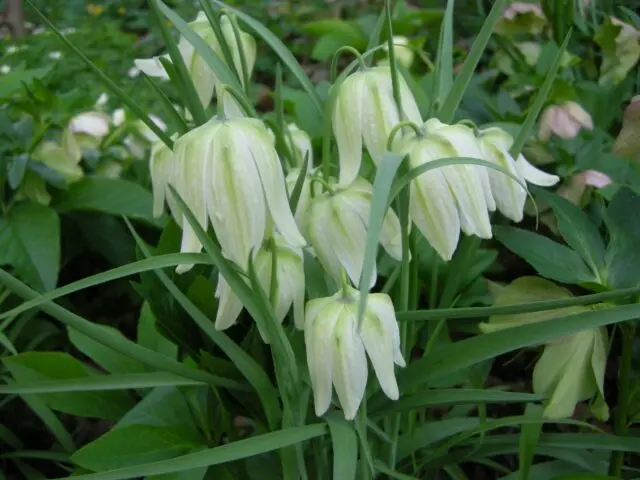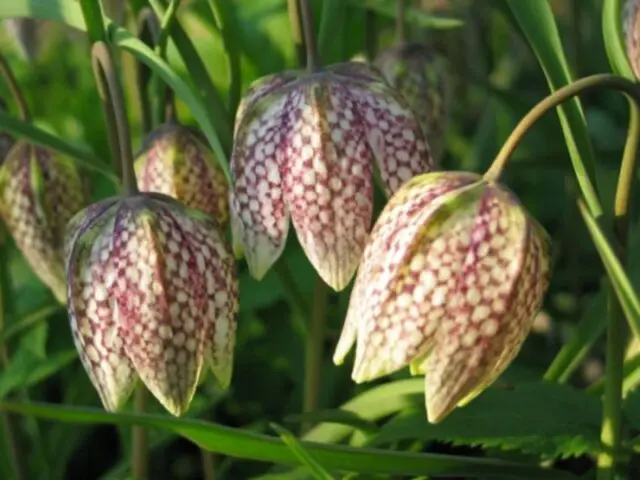Contents
Checkered hazel grouse (Fritillaria meleagris) is a perennial plant that belongs to the genus of the same name and is a member of the Liliaceae family. The plant is valued for the beauty of flowers and unpretentiousness. Under natural conditions, the hazel grouse is on the verge of extinction, therefore it is listed in the Red Book. But many gardeners grow it in their backyards, which allows them to preserve this unique plant. However, for the full development and flowering of perennials, it is necessary to create favorable conditions, taking into account the requirements of the culture.

The chess grouse has been cultivated since 1519
Description and characteristics of chess hazel grouse
This perennial is a squat herbaceous plant, the height of which barely reaches 35 cm. The shoots are thin, smooth. In their upper part, narrow linear leaves are alternately located in an amount of two to six pieces with a blunt tip. The length of the plates in the hazel grouse reaches 8-13 cm, and the width is 1 cm. The lower leaves are larger than the upper ones.
The root system of a perennial is represented by an onion. On its bottom, during the growing season, white absorbent processes are formed. The bulb of the hazel grouse is rounded, flattened, its transverse diameter is no more than 1,5 cm. It consists of two wide scales and is dressed in a brown membranous shell.
The flowers of the hazel grouse, as seen in the photo, are mostly solitary, but sometimes two appear. The buds are drooping. The perianth is bell-shaped, it is formed by oblong-ellipsoid petals, narrowed at the top and with a blunt tip. Honey grooves run along their midline. The petals have a dark purple checkerboard pattern that stands out clearly against a light pink or whitish background. On the inside, they have a yellowish color. The pistil is taller than the stamens. At the top, it is divided into three stigmas.
The fruits of the hazel grouse plant are a trihedral box, blunted at the top, in which there are small black seeds. They ripen at the end of July. After that, the vegetation of the plant ends, the bulb goes into a dormant stage and stays in it until the next spring.
When the hazel grouse blooms
The flowering period of the hazel grouse begins in mid-May and lasts for two weeks. But depending on the weather conditions and the location of the perennial in the garden, the dates can be shifted by 7-10 days.
Popular varieties
Ornamental varieties were obtained on the basis of wild-growing hazel grouse. They differ in different colors of flowers, and also have an increased level of vitality.
The most popular ones are:
- Alba (Alba) – height about 20 cm, white flowers.

Alba is ideal for alpine slides
- Jupiter (Jupite) – a shade of rich red flowers with a clearly defined pattern, plant height 25 cm.

Jupiter looks spectacular when combined with light varieties of culture
- Orion (Orion) – flowers of a purple hue with a pronounced light pattern, height reaches 30 cm.

Orion blooms five days later than other varieties
- Artemis (Artemis) – a purple shade of flowers with small green marks on the petals, plant height is about 25 cm.

The Artemis variety has been known since 1947.
When to plant hazel grouse
Planting of a chess hazel grouse should be carried out in the fall, namely in early September. In this case, the plant has time to take root in a timely manner before the arrival of frost.
How to plant a chess hazel grouse
For culture, it is necessary to choose slightly shaded places, protected from cold gusts of wind. When choosing, you need to take into account that the plant reacts poorly to stagnation of moisture in the soil. Therefore, the groundwater level on the site should be at least 1,5 m.
The plant is undemanding to the composition of the soil, but prefers well-drained nutrient soil rich in organic matter. In this case, the checkered hazel grouse forms large flowers, as in the photo, in large numbers. The best option for the plant is sandy soil and loam with a low level of acidity.
Two weeks before planting the plant, the site must be dug up and humus added at the rate of 10 kg per 1 sq. m. And in the case of loam, you also need to additionally add 5 kg of sand for the same area size.
Before planting the bulbs in open ground, it is necessary to soak them in a pink solution of potassium permanganate for 15 minutes, and then rinse with clean water and dry well. Landing should be carried out in holes, the depth of which should be three times the size of the bulb. Pour a layer of sand at the bottom of the recesses, and then put the bulbs on their side a little, which will eliminate the possibility of moisture stagnation between the scales in the future.
After planting, it is necessary to level the surface of the soil and sprinkle it with a layer of peat, no more than 1 cm thick.
Chess hazel grouse care
Perennials are easy to care for. Agrotechnics of hazel grouse includes standard procedures, including watering, fertilizing, loosening, timely transplanting and shelter for the winter. The viability of the plant and its flowering directly depend on the correctness of their implementation.
Watering
This plant does not tolerate stagnant moisture in the soil. Therefore, it should be watered moderately in the absence of rain for a long time. To do this, you can use settled water with a temperature of + 18-20 ° C. Moisturize in the evening. The recommended frequency of watering is 1-2 times every two weeks. It must also be carried out after the flowering of the hazel grouse, until the aerial part begins to fade, since the growth of the bulb continues during this period.
Additional fertilizing
For the full development and lush flowering of the hazel grouse, it is recommended to feed the plant twice per season. The first time fertilizers should be applied at the beginning of the growing season. During this period, you can use nitroammophoska at the rate of 30 g per 10 liters of water. The second time you need to feed the hazel grouse after flowering, so that the plant can restore strength and grow the bulb. At this time, you need to use potassium sulfide 25 g and superphosphate 30 g per bucket of water.
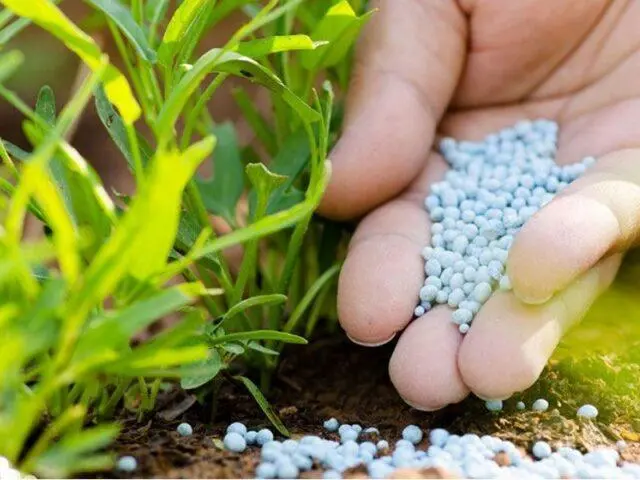
Fertilizers can be applied to the soil in a dry form, followed by incorporation into the soil and watering.
Loosening
Throughout the growing season, it is also important to periodically loosen the soil at the base of the perennial. This will prevent stagnant moisture and provide air access to the bulb. Loosening should be done after each rain or watering.
Shelter for the winter
The hazel grouse successfully winters in the conditions of central Our Country and does not require shelter for the winter. But in regions with more severe climatic conditions, it is necessary to cover the plant with a 5 cm thick layer of mulch in late autumn, and additionally lay spruce branches on top.
When transplanted hazel grouse chess
Sometimes it becomes necessary to plant a new place. You can carry out the procedure before and during flowering. In this case, the plant will have time to fully take root before the bulb goes into the dormant stage.
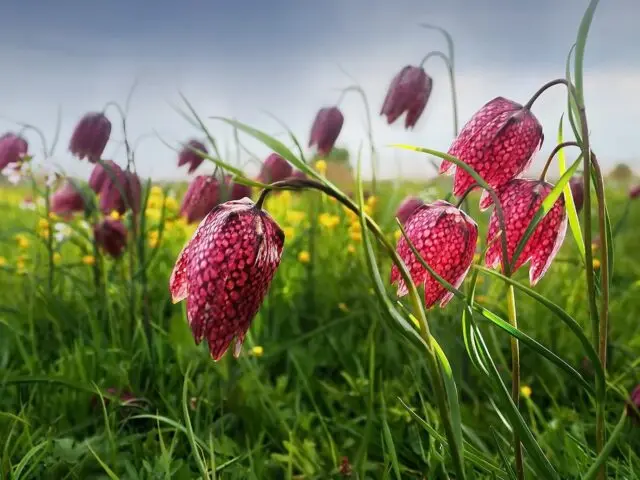
Grouse chess easily tolerates a transplant
Methods of reproduction
Perennials can be propagated by seeds and daughter bulbs. Each of these methods has features that need to be considered.
Bulbs
In the process of growing hazel grouse, children appear around the bulb, which subsequently begin to interfere with each other. In this case, you need to completely dig out the plant at the beginning of autumn, carefully separate the children and immediately plant them in a new place. And then water the site abundantly and, if necessary, cover for the winter.
Seeds
To propagate the hazel grouse, it is necessary to collect the fruits after they ripen and pour out the seeds from them. They can be planted directly in open ground. To do this, you need to level the area, make holes 10 cm wide and 1 cm deep, pour abundantly. After that, sow and cover the seeds with a layer of soil.
In this case, seedlings appear in the spring. And hazel grouses grown from seeds bloom for 3-4 years.
Diseases and pests
This perennial is characterized by high natural immunity, but in prolonged rainy weather it can be affected by gray rot. Then brown wet spots appear on the leaves, flowers and shoots of the hazel grouse. Subsequently, they are covered with a gray coating, which indicates the sporulation of the fungus. In this case, the plant must be sprayed with Bordeaux mixture or Fundazol.
Also, with stagnant moisture, the perennial suffers from root rot. This can be determined by the sharp yellowing of the aerial part. To save the plant, you need to dig it up, separate healthy bulbs, process them in Maxim’s solution and transplant them to a new place.
Of the pests, the lily hoverfly can cause damage to the hazel grouse. The insect has a red body and a black head. The pest and its larvae feed on the leaves and flowers of the plant. For destruction, it is recommended to treat the plantings of the hazel grouse with Aktellik or Fufanon.
Grouse chess in landscape design
This perennial is able to successfully fit into any landscape design and complement it. The white and dark varieties of hazel grouse in mono-plantings look especially impressive, as can be seen in the photo. Perennial suitable for alpine slides, borders, foreground flower beds. It can be combined with other spring bulb flowers to create eye-catching, eye-catching arrangements.
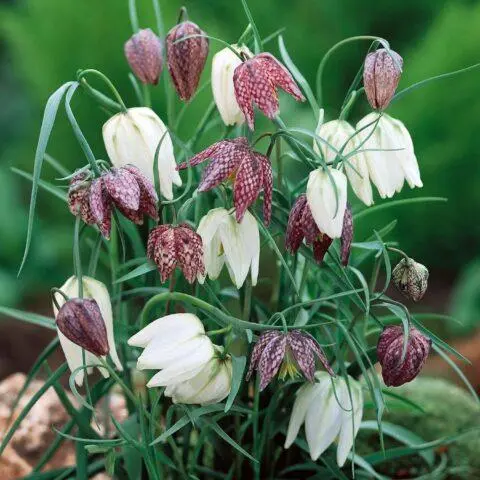
The plant exudes a specific aroma and is not suitable for planting near resting places.
Conclusion
Chess grouse is a culture that, with minimal care, can become a real decoration of the garden. After all, its drooping bell-shaped flowers look so elegant and gentle that few people can be left indifferent. In addition, growing a perennial does not cause any difficulties, so many flower growers give it preference.











